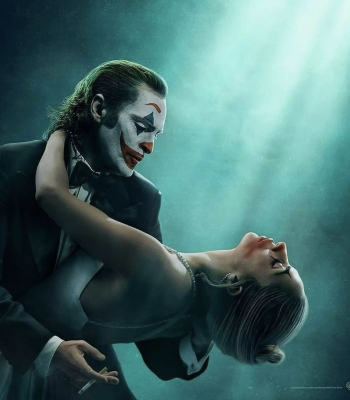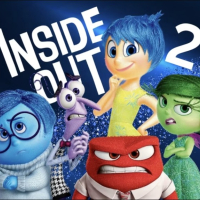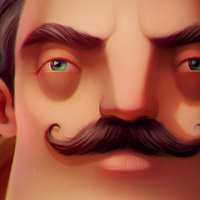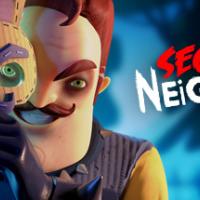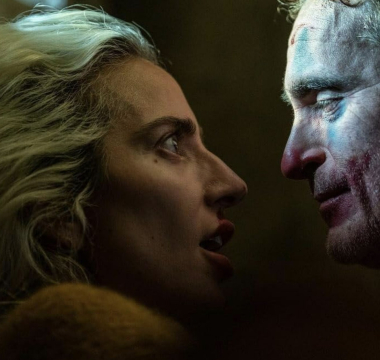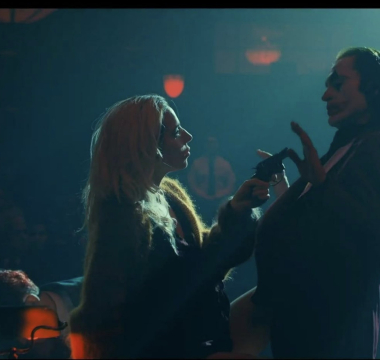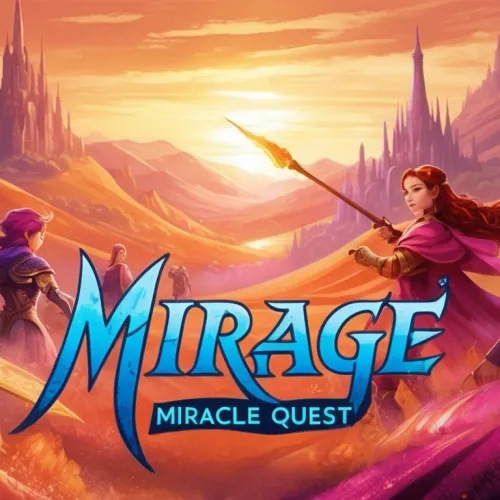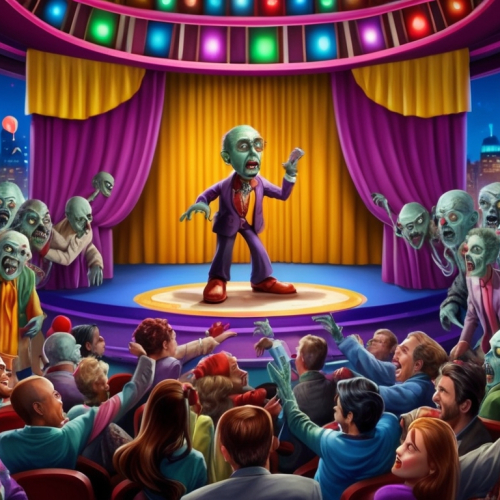Get ready to dive back into the tumultuous world of Gotham's most iconic villain with Joker: Folie à Deux. This electrifying sequel to the 2019 smash hit, directed by the visionary Todd Phillips, promises a mesmerizing blend of drama, romance, and musical flair.
With a fresh and intriguing twist featuring musical elements and the captivating presence of Lady Gaga as Harley Quinn Joker 2, dares to defy genre boundaries and explore the depths of madness and love.
Are you interested in how this sequel stacks up against its predecessor? Read on to discover the layers behind the spectacle.
Main information about the film:
-
Genre: crime, drama, thriller, musical
-
Directed by Todd Phillips
-
Cast of Joker: Folie à Deux: Joaquin Phoenix, Lady Gaga, Zazie Beetz, Brendan Gleeson, Catherine Keener and others
-
Studios: Warner Bros. Pictures, DC Studios, Joint Effort, Warner Bros. Pictures
A little later, we will discuss the main aspects of the new film. But first, let's remember how it all began.
A Rich Legacy of the Joker
A bit of background: The character of the Joker is one of the most iconic villains in the Batman universe, brought to life in memorable performances by Jack Nicholson in Tim Burton's 1989 "Batman" and Heath Ledger in Christopher Nolan's 2008 "The Dark Knight." However, the attempt to reboot the character with Jared Leto in the 2016 film "Suicide Squad" was less successful.
So, when it was announced that director Todd Phillips, known primarily for his comedic work like "The Hangover" series, would be directing a new Joker 2 film, many people were skeptical. They questioned the need for yet another portrayal of the character.
Nevertheless, in 2019, audiences were introduced to a completely different interpretation of the Joker. This version was not the insane mastermind of crime but a mentally unstable, unsuccessful clown living in a small apartment with a harsh mother. He lacked friends and love, was constantly bullied, and his jokes fell flat. He often escaped into his imaginary world, losing track of what was real and what wasn't until his darker side emerged.
The Birth of a Sequel: Joker's Musical Madness

Why is Joker Folie à Deux a musical? The idea for "Joker: Folie à Deux" came to Joaquin Phoenix shortly after wrapping up filming for the first movie. He dreamt of the Joker performing on stage, cracking jokes and singing.
"Todd was backstage, speaking to me through an earpiece. I woke up inspired and called him, hoping he’d want to create a show with me," the actor recalls.
The team initially considered developing a Broadway musical, but the process would have taken over four years, and Phoenix would have had to dedicate six months to performing every night. Thus, Phillips decided to take a risk and turn the Joker into a musical film instead.
Joaquin Phoenix also originated the idea of a "Joker-woman" to pair with Arthur Fleck. Unlike "Suicide Squad," where Margot Robbie played the supervillain, their character in "Folie à Deux" was crafted to be "more grounded."
"We removed the high-pitched voice, accent, gum-chewing, and all those brash elements from the comics. Our goal was for her to fit into the Gotham world created in the first film," the director explains.
"Todd really went for it with this concept and script, giving the Joker 2 movie boldness and complexity. There’s music, dancing, courtroom drama, and comedy, both joyful and melancholic. It shows that Todd, as a director, seeks to be creative, not just tell a traditional love story," describes Lady Gaga, who portrayed Harley Quinn.
Revisiting Arthur Fleck: An Evolution
"Joker (2019)" introduces us to Arthur Fleck, a troubled man living with his mother in Gotham City. Struggling as a failed comedian, Arthur never knew his father and battled a split personality between Fleck and the Joker. The film artfully depicts Arthur's descent into madness, making it almost relatable.
It concludes on an ambiguous note, as Arthur murders talk show host Murray Franklin on live TV and is then driven away by a police officer as riots erupt across the city. Amid the chaos, Thomas and Martha Wayne are murdered by a rioter, laying the foundation for Bruce Wayne's (Batman) backstory.

Unlike its predecessor, Joker 2 is a musical. While the movie is overall good, the choice to make it a musical seems inconsistent with "Joker (2019)." Although the musical numbers are well-executed, the decision to center them in the narrative appears questionable, given that the first movie had no musical aspects and Arthur was originally a comedian, not a musician.
Despite this inconsistency, the musical performances are surprisingly captivating, showcasing Lady Gaga’s talents and providing a visually engaging experience. They serve to propel the story forward and distinguish between reality and Fleck's delusions or Joker-like moments.
This installment is less thematically dark than the original. Since the intense crimes from "Joker (2019)" have already occurred, "Folie à Deux" explores a different kind of disturbance — focusing on asylums and the treatment of people with mental illnesses.
-
I found this film less unsettling and easier to watch than its predecessor. While it isn’t necessarily lighter in terms of humor or positivity, as it remains a dark story, the lighter moments come from Fleck's newfound joy with Quinzel — something absent in the first film. Despite this, "Folie à Deux" features less humor.
Fleck's jokes, although not intended to be amusing, are even less effective here due to poor writing rather than the character himself.
Psychological analysis of Joker
The Joker 2 is an extensive psychological analysis of Arthur Fleck. The film uses its runtime to immerse viewers into the protagonist's mind, examining his motivations and dissecting his complex nature. This exploration raises the question of whether such a layered character can truly be understood within two hours.
Though this approach risks becoming insubstantial, it unexpectedly transforms mundane moments into key narrative beats. The film skillfully balances simplicity and complexity, pushing forward with determination and style.
What Awaits Us on the Screen?
"Joker: Folie à Deux" is a unique film blending crime, drama, thriller, musical, and comic book elements, directed by Todd Phillips. It features notable talents such as Joaquin Phoenix, Lady Gaga, Zazie Beetz, Brendan Gleeson, and Catherine Keener.
The film picks up after the first installment, with Arthur Fleck (played by Joaquin Phoenix) now confined in Arkham Asylum following his transformation into Joker. His persona has become a symbol for the masses, even inspiring a film about him, yet he faces an uncertain future with impending court hearings. And what is the plot of Joker 2 finally?
In the film dives into the consequences of Arthur Fleck's actions and how they echo through the halls of Arkham Asylum. After the televised murder of Murray Franklin, Arthur, portrayed by Joaquin Phoenix, finds himself awaiting trial in the high-security wing of Arkham. His lawyer, Marianne Stewart (played by Catherine Keener), believes Arthur’s personalities – the man and the Joker – result from his traumatic childhood. Meanwhile, prosecutor Harvey Dent (Harry Lawtey) pushes for the death penalty, seeing Arthur as fully aware of his actions.
Arthur’s trial becomes a media spectacle, one of the first to be entirely broadcasted on television. The spotlight reignites the performer in him, sparking a transformation back to his Joker persona.
Enter Harleen Quinzel, or Joker 2 Harley Quinn, portrayed by Lady Gaga as "Lee." They quickly connect when Arthur encounters her in the minimum-security ward, finding shared understanding in their troubled pasts. Their relationship evolves through musical sequences, some perceived in the reality of Arkham, others created entirely in Arthur's mind.
As Arthur’s connection with Lee grows, so does the re-emergence of his Joker identity. In a televised interview following his arrest, he engages in a heated exchange with the host, disregarding his lawyer's advice and essentially embracing the showman buried within.
Targeting toxic fandom
The film turns a critical eye on toxic fan culture. Arthur's notoriety swells due to a TV movie about his case, turning him into a figurehead for certain societal fringes. Notably, Lee embodies an extreme version of this fandom, reminiscent of admirers who romanticize criminals. She fuels Arthur's darker side and rallies masses outside the courthouse.
Yet, her motives remain ambiguous. Suggestions of her manipulations linger, raising questions about her true intentions—whether she’s genuinely enamored or merely exploiting Arthur for her gains.
A layered discussion on the influence
Despite its strengths in crafting a coherent critique of fan culture, the film struggles with the same internal conflicts as its predecessor. It skillfully presents craftsmanship and performances, particularly Gaga's enigmatic portrayal of Lee. However, like the original, it occasionally falters in clarity, leaving room for misconceptions.
"Joker: Folie à Deux" played in theaters and debuted at the Venice Film Festival, with a runtime of 138 minutes. Joker 2 rating is R rating for explicit violence, pervasive language, some sexual content, and brief nudity.
Interesting facts about Joker: Folie à Deux
-
Joaquin Phoenix lost weight again for the role, similar to how he transformed his body for the first Joker film. His skeletal appearance emphasizes Arthur’s deteriorating mental state.
-
Lady Gaga co-wrote some of her character’s songs, adding a personal touch to Harley’s musical moments.
-
The title Folie à Deux not only refers to Joker and Harley's relationship but also reflects the spreading of collective madness.
-
Todd Phillips took inspiration from classic musicals, such as The Umbrellas of Cherbourg, blending them with the psychological horror of Joker’s world.
-
Live performances captured on set: Lead actors Lady Gaga and Joaquin Phoenix performed all their vocal scenes live on set, accompanied by a live piano. Despite the option to pre-record tracks in a studio, Phillips decided against it to maintain spontaneity and authenticity during filming.
-
Constructing Arkham Asylum: Arkham Asylum, a fictional psychiatric institution in Gotham City from the DC Universe, is a key location in the sequel. Production designer Mark Friedberg chose one of the Joker 2 filming locations, a historic 1920s building near Newark, previously a tuberculosis sanatorium. Surrounding it with extensive fencing and security details gave the impression of an isolated island, enhancing the sense of inescapability.
The Theme of Shared Madness: What is Folie à Deux?
The film’s subtitle, "Folie à Deux," a French term meaning "madness shared by two," is a psychiatric condition where symptoms of a delusional belief are transmitted from one individual to another. This concept intricately weaves through the film's narrative, offering insights into the complex relationship between Arthur and Harleen. The idea delves into mental influence, where a dominant personality can impose their mental state onto another, creating a shared psychosis.
The French term also adds a layer of sophistication, echoing themes of romance and creativity. Notably, "Folie à Deux" is also an album by rock band Fall Out Boy, adding an interesting, though incidental, cultural reference to the mix, further enriching the movie's thematic diversity.
Enter Harleen Quinzel: A New Perspective
One of the most anticipated aspects of Joker 2 a musical was the introduction of Harley Quinn, portrayed by Lady Gaga. Fans of the Joker lore know Harley as the psychiatrist who falls in love with the Joker and eventually becomes his partner in crime. However, Gaga’s version of Harleen Quinzel is a fresh take on this familiar character.

Stefani Germanotta, better known by her stage name Lady Gaga, had her first on-screen appearance at 15 with a minor role in the iconic series "The Sopranos." However, it was not until the late 2000s, when she gained fame as Lady Gaga, that she started receiving guest roles in popular films and series, such as "The Simpsons" and "Sin City: A Dame to Murder For." Her first leading role came in 2015 with "American Horror Story: Hotel."
Lady Gaga's serious acting abilities were recognized with the release of Bradley Cooper's musical drama "A Star Is Born." In this film, she plays a central role as a young, talented singer who rises to fame following her encounter with a troubled country musician, leading to a tragic conclusion. Her performance earned her an Oscar nomination for Best Actress and won her the award for Best Original Song.
Subsequently, she starred in Ridley Scott's biopic "House of Gucci," showcasing her acting without singing. This might have prompted directors to revisit her singing talent in films, culminating in "Joker 2" being made as a musical. Lady Gaga in Joker 2 sings so extensively in this film that by the end of the pre-release screening, some viewers felt a bit overwhelmed. Her singing was impressive but arguably excessive.
Joaquin Phoenix delivered his usual strong performance, but it felt somewhat repetitive, with his iconic emaciated look, slouched posture, hysterical laughter, and the suffering of his downtrodden character— elements that captivated audiences and critics in 2019 and brought him his long-awaited Oscar win. This time, however, it seemed more like a retread.
Alongside Phoenix and Gaga, the film features Brendan Gleeson ("In Bruges," "The Banshees of Inisherin") as one of the Arkham guards, Harry Lloyd ("The Pale Blue Eye," "Industry") as prosecutor Harvey Dent, and Catherine Keener ("Get Out," "The Adam Project") playing Arthur Fleck’s lawyer Marianne Stewart.
Zazie Beetz ("Deadpool 2," "Bullet Train") reprises her role as Sophie Dumond, the cynical single mother and unrequited love interest from the first film, although her screen time is very brief.
The Relationship Between Joker and Harley
At its core, "Joker: Folie à Deux" is a love story between two individuals of dubious moral standing and complex motivations. Harleen Quinzel, in particular, emerges as a multi-dimensional character with her secrets and motives, keeping her true intentions toward Arthur ambiguous until the film’s conclusion.
Lady Gaga's portrayal of Harleen is captivating, providing a new perspective on the character within contemporary portrayals of Harley Quinn. Her performance is pivotal, especially when playing alongside Joaquin Phoenix, who returns with his exceptional acting chops.

A Musical Twist: The Surprising Use of Music
The film intertwines musical elements with its narrative, an unexpected yet fitting choice considering Lady Gaga's extraordinary vocal prowess. Her performances stand out, offering an exquisite auditory experience complemented by Joaquin Phoenix’s efforts to match her musical contributions. Approximately 75% of the film’s musical scenes predominantly feature Lady Gaga, highlighting her talents.
These musical interludes are not merely auditory treats but are designed to provide deeper insights into Arthur's internal struggles. Where the first film explored social themes, this one turns inward, dissecting Arthur's psyche and unraveling the nuances of his worldview, providing a nearly two-hour-long dive into his psychological state.
In "Folie à Deux," music plays a central role. The first "Joker" film showed Arthur watching old Hollywood musicals on TV with his mother, and "Folie à Deux" brought that influence to life by letting Arthur’s imagination manifest through song and dance. These scenes vary from intimate duets with Lee to elaborate productions on grand sets filled with large casts and extravagant action.
While "Joker" drew inspiration from Martin Scorsese’s “The King of Comedy,” "Folie à Deux" takes cues from James Thurber’s "The Secret Life of Walter Mitty" and Dennis Potter’s "Pennies from Heaven," where main characters express their rich fantasy worlds through music. Unlike "Pennies from Heaven," where lip-synching was used, Phoenix and Gaga performed their songs live on set, capturing the rawness of live music.
This live performance approach has been highlighted: Joker 2 Gaga and Phoenix sing live as the cameras roll, not lip-synching to pre-recorded versions. Gaga, renowned for her powerful voice, deliberately tones it down to match the intimate, less polished vibe required for some scenes.
However, this effort is sometimes a directorial choice that constrains her natural style. In contrast, the polished orchestral backing and the lavish production of the scenes seem contradictory to the intended spontaneity and intimacy.
Whether grounding the musical numbers in reality, like when Arthur imagines showing off in an asylum common room, or venturing into fantasy, such as in a mock wedding scene with a jazz club setting, director Phillips doesn’t imbue them with much physicality or flair to match the energy of the music.
The portrayal of music and dance in film can align more closely with the bold and imaginative world of comic-book art than action scenes, no matter how dynamic or intense. Still, the musical sequences in "Folie à Deux" lack a strong visual identity; despite detailed sets, they mostly feel like standard visual recordings with little stylistic touch.
The overpowering instrumental background often drowns out the vocals, diminishing their impact. Phillips seems content with merely suggesting the concept of musical fantasy without giving it a truly unique identity. Although Phillips’s past work isn't known for its lyrical quality, the close connection of the musical fantasies to the Joker 2 plot and their purpose in illustrating the protagonist’s mental state make these sequences feel particularly mundane.
Visual and Cinematic Style: A Dark and Beautiful World

Visually, Joker: Folie à Deux is just as striking as its predecessor. The film’s aesthetic continues the gritty, bleak atmosphere, but there are moments of surreal beauty as well.
The camera work is deliberate and intimate, often lingering on close-ups of the Joker 2 characters to capture their emotional intensity. This is especially effective in scenes where Joker and Harley interact, as their facial expressions and body language convey as much, if not more, than the dialogue.
From a visual perspective, "Joker: Madness for Two" still maintains its stunning appearance. The filmmakers continue to leverage crimson, greenish, and yellow hues, creating a sickly atmosphere that accentuates Joker's changing world with vibrant blue and red tones. The background is filled with the unsettling soundtrack — although this time, it feels overly repetitive, especially during dramatic scenes where the same oppressive melody frequently plays.
Narrative Structure
Despite an intriguing concept, Joker 2 2024 lacks a convincing story. While the script of the first film had flaws, it captivated audiences. Viewers followed the journey of Arthur Fleck, a lonely man who experienced violence in childhood and adulthood, felt betrayed by the social system, and decided to retaliate against the world as Joker. The film broached anarchy, social responsibility, politics, and mental illness.
Thematic Exploration
The original "Joker" film faced criticism, yet its script was cohesive, with a clear understanding of its intentions. Unfortunately, "Joker: Madness for Two" doesn't exhibit the same clarity. The sequel revisits the same themes as its predecessor but handles them more loosely. Social responsibility and mental health issues are examined through the lens of the court, but the film fails to present anything new beyond what was explored in the first installment.
Missed Opportunities
The integration of musical elements and the introduction of Harley Quinn were meant to bring a fresh dimension to the storyline. However, neither aspect was fully realized. The potential of both the musical sequences and Harley's character still needs to be explored, leaving them underutilized in the narrative.
Character Dynamics
The film attempts to delve deeper into the psyche of its characters, with Arthur Fleck's transformation into Joker already established. However, the new dynamics, especially between Joker and Harley Quinn, need to offer the anticipated complexity and depth. The development of their relationship, which could have added another layer to the story, feels superficial and unexplored.
Repetitive Soundtrack
One of the notable aspects is Joker: Folie à Deux soundtrack, but it has its challenges. While effective in setting a tense atmosphere, the music often becomes repetitive. Key dramatic scenes are accompanied by the same haunting melody, diminishing the impact and making the score predictable rather than enhancing the narrative.
Visual Storytelling
Although visual storytelling remains one of the film's strengths, it sometimes overshadows the plot. The intricate use of color and composition is compelling, yet it compensates for the narrative's shortcomings rather than complement it. The visual elements create a vividly unsettling world, but they cannot fully mask the lack of substantial storytelling.
A Film That Left Mixed Feelings Behind…
So, what is Joker 2 about? Viewed in its entirety, "Joker: Folie à Deux" is an extended epilogue to its predecessor. The narrative often circles back, reflecting on Arthur’s actions and decisions from the first film. Instead of introducing fresh insights, it leans towards evoking emotions rather than stimulating critical thought.
The film ambitiously oscillates between multiple genres—courtroom drama, crime story, social commentary, and an innovative take on the DC Comics universe. Its frenetic pace and shifting tones challenge conventional storytelling, creating new focal points and diminishing old ones as the narrative unfolds.
"Joker: Folie à Deux" invites neutral observation and in-depth analysis, filled with intricacies and nuances that offer countless discussion points. Yet, at its core, it challenges audiences to engage with a work that is as much about unseen emotions as its actual content, leaving an indelible mark on viewers’ imaginations.
